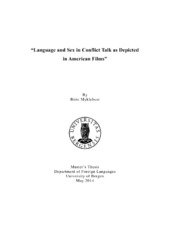Language and sex in conflict talk as depicted in American films
Master thesis
Permanent lenke
https://hdl.handle.net/1956/7957Utgivelsesdato
2014-05-15Metadata
Vis full innførselSamlinger
Sammendrag
This thesis aims to investigate gender differences in language conducive to conflict. The research question is: Is there a difference between men and women as to how conflicts are handled linguistically? Five linguistic characteristics conducive to conflict were chosen to investigate gender differences, viz. the use of identification, the passive voice, generalizations, bipolarity and inferences versus descriptions. The data was chosen from American movies with characters belonging to the same social class, which could be characterized as middle-class. The hypotheses regarding male majority when it comes to the production of identification, the passive voice and generalizations were quantitatively corroborated. Both the category of identification and of generalizations were divided into two subcategories because of recurring patterns found in the analysis. This resulted in identification as initiation, identification as response, absolute generalizations and modified generalizations. The male characters had majority in both identification as initiation and absolute generalizations, while the results for identification as response and modified generalizations showed an equal distribution. The results showed an almost equal distribution of the hypothesized male majority of bipolarity. The hypothesis of the use of inferences and descriptions was refuted, with the female characters producing more inferences than the males, and the male characters producing more descriptions than the females. The investigation of descriptions, however, showed an interesting result. The use of descriptions are seen as an aid in lowering the level of abstraction in language, making it more reflective of non-verbal reality and less conducive to conflict. The results showed that even though male characters overall produced more tokens of descriptions, women initiated descriptive sequences after the use of high-abstract language use almost twice as many times as the males. This shows a tendency of women being more preoccupied with keeping language accurate and tangible than men.
